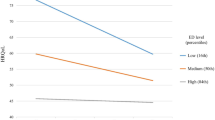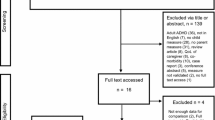Abstract
It has never been investigated whether the assessment tools of Adult Attention Deficit Hyperactivity Disorder Quality-of-Life (AAQoL) scale and the SF-36 measure the same construct. The participants were 101 parents of children with ADHD and 243 parents of school children. The parents completed both the Persian version of the AAQoL and the SF-36 questionnaires. The present study revealed that the Persian version of both AAQoL and SF-36 for the assessment of HRQoL in parents of children with ADHD has convergent and discriminant validity and internal consistency. Multitrait–multimethod correlation matrix showed that the domains of two questionnaires were moderately correlated. Current results support that AAQoL and SF-36 in parents of children with ADHD measure the same HRQoL constructs. Hence, for assessing the HRQoL of parents of children with ADHD, one of the two questionnaires can be used regard to the objective of study. The Persian version of the AAQoL loaded on four domains which were in line with the original version. HRQoL of parents of children with ADHD is markedly less than the community sample of children.
Similar content being viewed by others
References
Able SL et al (2007) Functional and psychosocial impairment in adults with undiagnosed ADHD. Psychol Med 37(01):97–107
Arafa MA et al (2008) Quality of life among parents of children with heart disease. Health Qual Life Outcomes 6(1):1
Barkley RA (2014) Attention-deficit hyperactivity disorder: a handbook for diagnosis and treatment. Guilford Publications, New York
Beaton DE et al (2000) Guidelines for the process of cross-cultural adaptation of self-report measures. Spine 25(24):3186–3191
Benjak T et al (2009) Comparative study on self perceived health of parents of children with autism spectrum disorders and parents of nondisabled children in Croatia. Croat Med J 50(4):403–409
Biederman J (2004) Impact of comorbidity in adults with attention-deficit/hyperactivity disorder. J Clin Psychiatry 65(3):1477–1478
Biederman J et al (1992) Further evidence for family-genetic risk factors in attention deficit hyperactivity disorder: patterns of comorbidity in probands and relatives in psychiatrically and pediatrically referred samples. Arch Gen Psychiatry 49(9):728–738
Biederman J et al (1995) High risk for attention deficit hyperactivity disorder among children of parents with childhood onset of the disorder: a pilot study. Am J Psychiatry 152(3):431–435
Brod M et al (2005) Conceptualization and assessment of quality of life for adults with attention-deficit/hyperactivity disorder. Prim Psychiatry 12(6):58–64
Brod M et al (2006) Validation of the adult attention-deficit/hyperactivity disorder Quality-of-Life Scale (AAQoL): a disease-specific quality-of-life measure. Qual Life Res 15(1):117–129
Chassany O et al (2002) Patient-reported outcomes: the example of health-related quality of life—a European guidance document for the improved integration of health-related quality of life assessment in the drug regulatory process. Drug Inf J 36(1):209–238
Cohen J (1988) Statistical power analysis for the behavior science. Lawrance Eribaum Association, Mahwah
Faraone SV et al (2000) Attention-deficit/hyperactivity disorder in adults: an overview. Biol Psychiatry 48(1):9–20
Fayers PM, Machin D (2013) Quality of life: the assessment, analysis and interpretation of patient-reported outcomes. Wiley, London
Ghanizadeh A (2008) Distribution of symptoms of attention deficit-hyperactivity disorder in schoolchildren of Shiraz, south of Iran. Arch Iran Med 11(6):618–624
Ghanizadeh A, Jafari P (2010) Risk factors of abuse of parents by their ADHD children. Eur Child Adolesc Psychiatry 19(1):75–81
Ghanizadeh A et al (2008) Comorbidity of psychiatric disorders and parental psychiatric disorders in a sample of Iranian children with ADHD. J Atten Disord 12(2):149–155
Ghanizadeh A et al (2011) Attention deficit hyperactivity disorder in imprisoned individuals—a review. Psychiatr Danub 23(2):139–144
Ghanizadeh A et al (2012) Psychiatric problems and suicidal behaviour in incarcerated adolescents in the Islamic Republic of Iran. East Mediterr Health J 18(4):311
Kessler RC et al (2005) The World Health Organization Adult ADHD Self-report Scale (ASRS): a short screening scale for use in the general population. Psychol Med 35(02):245–256
Lv R et al (2009) Depression, anxiety and quality of life in parents of children with epilepsy. Acta Neurol Scand 120(5):335–341
Magnússon P et al (2006) Validity of self-report and informant rating scales of adult ADHD symptoms in comparison with a semistructured diagnostic interview. J Atten Disord 9(3):494–503
Matza LS et al (2007) Responsiveness of the adult attention-deficit/hyperactivity disorder quality of life scale (AAQoL). Qual Life Res 16(9):1511–1520
Montazeri A et al (2005) The Short Form Health Survey (SF-36): translation and validation study of the Iranian version. Qual Life Res 14(3):875–882
Murphy K, Barkley RA (1996) Attention deficit hyperactivity disorder adults: comorbidities and adaptive impairments. Compr Psychiatry 37(6):393–401
Ramos-Quiroga JA et al (2013) Attention deficit hyperactivity disorder in the European adult population: prevalence, disease awareness, and treatment guidelines. Curr Med Res Opin 29(9):1093–1104
Rowland AS et al (2013) The prevalence of ADHD in a population-based sample. J Atten Disord. doi:10.1177/1087054713513799
Sharma S (1995) Applied multivariate techniques. Wiley, London
Ware JE Jr, Sherbourne CD (1992) The MOS 36-item short-form health survey (SF-36): I. Conceptual framework and item selection. Med Care 30(6):473–483
Wolraich ML et al (1996) Comparison of diagnostic criteria for attention-deficit hyperactivity disorder in a county-wide sample. J Am Acad Child Adolesc Psychiatry 35(3):319–324
Yamada A et al (2012) Quality of life of parents raising children with pervasive developmental disorders. BMC Psychiatry 12(1):1
Acknowledgments
This work was supported by the Grant Number 90-5844 from Shiraz University of Medical Science Council. This article was extracted from Roghaye Zare’s Master of Science thesis.
Author information
Authors and Affiliations
Corresponding author
Ethics declarations
Conflict of interest
The authors declare that they have no conflict of interest.
Human and animal rights
Research involved human participants.
Informed consent
All participants signed an informed consent form that was specifically designed for the current study.
Rights and permissions
About this article
Cite this article
Zare, R., Jafari, P. & Ghanizadeh, A. Do Adult Attention Deficit Hyperactivity Disorder Quality-Of-Life (AAQoL) scale and the SF-36 scale measure the same construct of health-related quality of life?. ADHD Atten Def Hyp Disord 9, 39–45 (2017). https://doi.org/10.1007/s12402-016-0206-5
Received:
Accepted:
Published:
Issue Date:
DOI: https://doi.org/10.1007/s12402-016-0206-5




